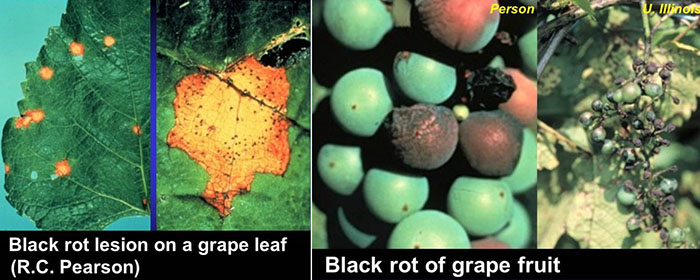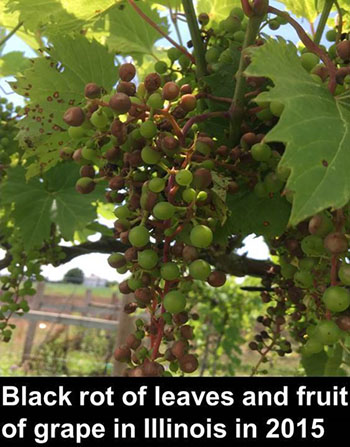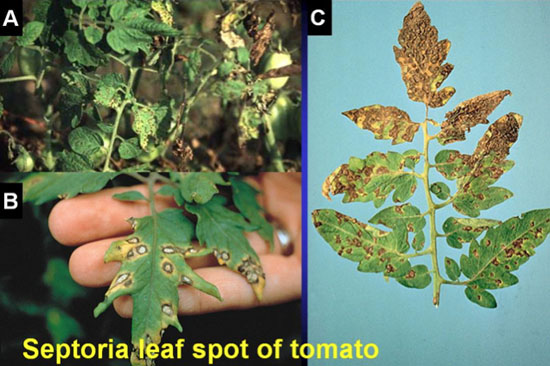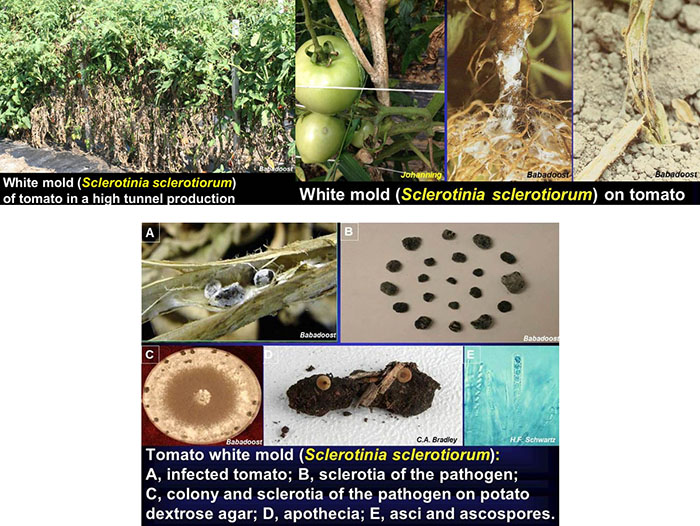"We are what we repeatedly do. Excellence, then, is not an act, but a habit." --Aristotle
Address any questions or comments regarding this newsletter to the individual authors listed after each article or to its editor, Rick Weinzierl, 217-333-6651, weinzier@illinois.edu. To receive e-mail notification of new postings of this newsletter, call or write the same number or address.
In This Issue:
Upcoming Programs (listings for beginning and established growers)
Regional Reports (from southern and western Illinois)
Fruit Production and Pest Management (spotted wing Drosophila, black rot of grapes)
Vegetable Production and Pest Management (Septoria leaf spot and white mold of tomato)
Upcoming Programs
Check the Illinois SARE calendar for a full list of programs and links for registration.
http://illinoissare.org/ and http://illinoissare.org/calendar.php
Also see the University of Illinois Extension Local Food Systems and Small Farms Team's web site at:
http://web.extension.illinois.edu/smallfarm/ and their calendar of events at http://web.extension.illinois.edu/units/calendar.cfm?UnitID=629.
- St. Charles Horticulture Research Center Twilight Meeting, July 16, 2015. 6:30 p.m. at the University of Illinois St. Charles Horticulture Research Center, located 45 miles west of Chicago at 3480 Lincoln Hwy. St Charles, IL, 60174 (on IL Rt. 38, 5.5 miles east of IL Rt. 47, or 1.5 miles west of Kane County Randall Road). Tour the vegetable research being conducted by University of Illinois researchers at the facility. Vegetable variety trials at St. Charles this season include sweet corn, heirloom tomatoes, specialty hot peppers, sweet potatoes, and cucurbits. See new plantings of apples, peaches, grapes and other fruits. The Beginning Farmer and Rancher Development Program (www.newillinoisfarmers.org) will also be highlighted, and visitors will be given a walkthrough of the high tunnel. There is no fee or pre-registration to attend. For more information, contact Dr. Shelby Henning at 630-584-7254, or shenning@illinois.edu.
- Southern Illinois Summer Twilight Series Meeting, July 20, 2015. 6:00 p.m. at Sunnybrook Gardens. 1152 Martin Dr., Carmi, IL 62821. Learn about a diverse fruit and vegetable production system, including a new frozen sweet corn processing venture and the specialty equipment used at this farm. Program is free but pre-registration is required by June 17 at https://web.extension.illinois.edu/registration/?RegistrationID=12654 or by phone at 618-382-2662. For more information, check the link provided or contact: Bronwyn Aly at baly@illinois.edu or 618-382-2662 or Nathan Johanning at njohann@illinois.edu or 618-687-1727.
Regional Reports
From southern Illinois ... Rain remains the topic of most conversations. For the month of June, I recorded 9.4 inches at my office in Murphysboro, and I think that is about average for most of southern Illinois. About 7 inches of that total came within about a 7- to 10-day period late in the month. By the local weather reports, this June has gone down as one of the wettest if not the wettest month on record.
The rain has made it a challenge for many of our crops. A common observation is of tomatoes wilting from saturated soils for too many days in a row. On flat ground with poor drainage, standing water has been common.
Spotted wing Drosophila (SWD) is active in southern Illinois. I first observed SWD at home in Monroe County in black and red raspberries on June 21, and since have seen and heard other reports of infested fruit in Jackson County as well. To date, I have observed larvae in raspberries and blackberries but not in blueberries. Refer back to IFVN issue 20:17 from March 19th for more details on SWD management.
At home, between the rain showers I was able to get pumpkins transplanted, and the rains and moist soils have been a good thing (in moderation) for them compared to many droughty years at this point in time. I am still picking some 'Bluegold' and 'Bluecrop' blueberries, with 'Chandler' starting to come on as well. Many of the main-season thornless blackberries ('Chester', 'Dirksen', and 'Black Satin') are starting to show some red color. The first early peaches I saw (and tasted) were out on the market in the third week of June, with many more coming in since then.
Nathan Johanning (618-939-3434; njohann@illinois.edu)
From western Illinois ... Like everyone else in the state, we're wondering why we didn't plant rice this year instead of vegetables. I don't know that I can remember being this wet in June before, and I do remember 1993 and 2008 (I was helping sandbag both years along the Mississippi, and both years those efforts were unsuccessful as the levee broke). I just heard we just experienced the wettest June on record (https://climateillinois.wordpress.com/).
Folks are trying to keep their head above water, literally and figuratively. It's hard to walk in fields, much less care for and harvest crops. Forget planting succession crops. Walking through our sweet corn, I'm sinking in 6 inches (or however deep the soil was worked prior to planting) and trying to keep the boots on my feet. The only places where I don't sink in is where the tractor tires traveled. No-till fields are holding up much better though.
Crops suffer in several ways due to the excess water. Saturated soils have no oxygen, which means that after a couple of days of saturated conditions, roots begin to die off. No functioning root system means no fertility uptake. Young crops suffer more than established crops do. Yellowing of foliage is probably the first symptom of nitrogen deficiency, which is an indicator of no or low nitrogen in the plant. This may or may not be due to low N levels in the soil. As stated above, root systems are not very effective under saturated soil conditions. The classic example is corn, where the lower leaves will turn yellow at the leaf margins, starting at the leaf tip. Applying nitrogen under these conditions will not help. Wait until the soils dry and the crop is growing before making the determination to provide supplemental nitrogen.
Nitrogen can be lost through several ways – leached through the soil; denitrified under saturated conditions; or if applied on the surface, washed off by rainfall. Any nitrogen that is in the nitrate form can be leached or denitrified. In most clay soils, denitrification will be the main N loss mechanism. All nitrogen applied in April is most likely in the nitrate form. At current soil temperatures, each day the soil is saturated, 3 to 5 percent of nitrate nitrogen will be denitrified by soil organisms. Waiting until soils dry before applying any rescue N is advised.
Rainfall and high humidity also dramatically increase plant disease concerns. Because it has been raining 3 to 5 times per week, disease pressure is high. Keeping a diligent spray schedule is not easy, but under these conditions, expect heavy pressure. The rule of thumb is that one inch of rainfall washes off most pesticides (fungicides and insecticides).
High tunnel tomatoes are approaching full production. Other high tunnel crops (cucumbers, peppers, etc.) are also coming along nicely. We really haven't seen much sun in the past 3 weeks, but crops seem to be maturing rapidly. Early sweet corn harvest is starting, which is about the earliest ever. Green beans, summer squash/zucchini, cole crops, early onions, greens, potatoes, peas, kale, etc. are all being harvested. Raspberry harvest continues as does blueberry harvest.
Weed control is a big issue and problems will worsen over the next few weeks. I'm seeing waterhemp germinate on the surface residue, not the soil. There is no way any residual herbicide can provide lasting control with the rains that continue to fall. There aren't many residual herbicides available for vegetable growers and post-emerge options are limited. Glyphosate may be a product that some will choose to help clean up fields or row middles. Just recall that glyphosate is a systemic product and small amounts of drift onto vegetable crops (especially small sized plants) can be damaging. The Midwest Vegetable Production Guide provides listings of labeled post-emerge herbicide choices.
Pumpkin producers normally like to plant their crop beginning in early June (depending upon location in IL). Many are behind in these efforts. The earliest maturing varieties are in the 95-day range, which would place them maturing in mid-October if soils dry to allow planting after July 4. Consider starting seeds in transplant cells in the hopes that soils will dry at a later date. Let's hope for a warm summer.
Mike Roegge (217-223-8380; roeggem@illinois.edu)
Fruit Production and Pest Management
Quick notes on spotted wing Drosophila
Since June 22 we have consistently captured a few spotted wing Drosophila flies in traps at the University of Illinois Fruit Research Farm at Urbana (12 traps checked 2-3 times per week). Numbers of adults captured in traps have not been high (less than 3 per trap over 2-3 days), and nearly all have been females. On June 17 we first found larvae in mulberries and tart cherries by using sugar water flotation, and earlier this week we found 90 larvae per 50-gram sample of black raspberries and 197 larvae per 50-gram sample of red raspberries. (Samples came from unsprayed plants at University of Illinois Fruit Research Farm at Urbana.) Everyone who grows raspberries and blackberries commercially (and backyard growers as well) must control this insect to see a marketable or usable crop. See the March 19, 2015, issue of this newsletter for information on scouting and management.
Rick Weinzierl (217-244-2126; weinzier@illinois.edu)
Black Rot of Grape
Black rot of grapes is severe in some Illinois vineyards. Black rot, caused by the fungus Guinardia bidwelli, is one of the most serious diseases of grapes in Illinois and throughout the Midwest. The fungus attacks all green parts of vines – leaves, shoots, leaf and fruit stems, tendrils, and fruits. The most damaging effect is to the fruit. When warm and moist weather in the spring and summer is prolonged, unsprayed fruit on susceptible varieties may become almost completely rotted. Infected berries turn dark brown and then black fungus fruiting bodies (pycnidia) develop on the surface. Most of the diseased berries drop early. The remaining infected berries eventually turn into shriveled, hard, black mummies. In the late spring, brown circular to angular lesions develop on the upper surface of the leaves. Within a few days, black spherical pycnidia form within the lesions. The black rot fungus overwinters in mummified berries on the soil or in old clusters still hanging on the vines. During moist weather, spores are produced and carried by air currents onto new growth. The infection becomes visible in about 10 days.


Black rot can be managed effectively if the following cultural and chemical practices are used.
- Sanitation. Removal of old, infected wood, tendrils, and clusters with mummified berries from the vines and wires greatly reduces overwintering inoculum.
- Reducing wetness period. Choosing a planting site with good exposure to sun and air circulation, proper pruning of vines, and controlling weeds in the vineyard reduce the time that vines remain wet, limiting the amount of infection.
- Resistant varieties. Where possible, choose a less susceptible variety. Consult the Midwest Small Fruit Pest Management Handbook for ratings of black rot resistance.
- Fungicide applications. Follow the grape spray schedule outlined in the 2015 Midwest Small Fruit and Grape Spray Guide. Application of fungicides in the early season and thorough coverage of plant parts will effectively reduce disease pressure during the season. Several fungicides including Abound, Bayleton, Ferbam, Flint, Inspire Super, Mancozeb, Mettle, Pristine, Quadris Top, Rally, Revus Top, Sovran, Tebuzol, Vintage, and Ziram are effective against black rot. Always read and follow the label directions.
Mohammad Babadoost (217-333-1523; babadoos@illinois.edu)
Vegetable Production and Pest Management
Septoria Leaf Spot and White Mold of Tomato
Septoria leaf spot and white mold of tomato have been observed in tomato fields and high tunnels. Current weather conditions are very conducive for both of these diseases, particularly for Septoria leaf blight. Necessary practices are needed to prevent further damage by these diseases.
Septoria leaf spot, caused by the fungus Septoria lycopersici, is one of the most destructive diseases of tomato in Illinois and worldwide. It is particularly severe in areas where wet, humid weather conditions persist for extended periods.
Symptoms usually appear on the lower leaves after the first fruit sets. They appear as small, water-soaked spots that soon become circular, about 3 mm in diameter, with dark brown margins and tan to gray centers (see the photos). The light-colored centers of the spots are dotted with black fruiting bodies (pycnidia) of the fungus, which are the most distinctive symptom of Septoria leaf spot. A yellow halo is often associated with leaf lesions. If the leaf lesions are numerous, infected leaves may wither. Lesions also develop on stems, petioles, and the calyx. These lesions are generally smaller and darker brown than those on leaves. The disease spreads upward, from oldest to youngest growth. Fruit infection is rare.

Septoria lycopersici overwinters on infected tomato debris or debris of solanaceous weed hosts. The fungus can also survive on stakes and cages and be spread by seed. Under wet conditions, numerous spores (conidia) are produced in the pycnidia and are exuded. The fungus can be spread from plant to plant by splashing water, workers, equipment, and insects. Temperatures between 68 and 77°F (20-25°C) are optimum for infection, symptom expression, and development of pycnidia. Leaf spots can appear within 5 days from infection, pycnidia form within 7-10 days, and spore production is repeated within 10-13 days.
Septoria leaf spot can be managed by a combination of cultural practices and fungicide use, including planting pathogen-free seed and disease-free seedlings; providing sufficient space between the plants for rapid drying; staking plants to improve air circulation and reduce the contact between foliage and soil; watering the plants at the base and in the morning to allow the plants dry before night dew; avoiding working with plants when foliage is wet; removing plant debris in the fall and plowing under the remaining plant residue; crop rotation with nonhost crops for 3-4 years; and spraying plants with effective fungicides. There are several effective fungicides for control of Septoria leaf spot; see the 2015 Midwest Vegetable Production Guide for Commercial Growers. Results of field trials in Illinois have shown that weekly spray-application of Quadris alternated with chlorothalonil (Bravo Weather Stik 6F) are effective.
White mold (also known as Sclerotinia stem rot and timber rot), caused by the fungus Sclerotinia sclerotiorum, is a disease of tomato whenever cool conditions prevail during crop development. The pathogen causes disease in more than 360 plant species, including many vegetable crops. In Illinois, white mold occurs mostly in high tunnels.
White mold is usually first noted on tomato about the time of flowering. Infection usually begins in leaf axils or in stem joints where flower petals have fallen. Water-soaked areas develop at these sites. The stems are subsequently invaded and become light gray, and plants die (see the photos). During cool, moist weather, cottony mycelial growth is often evident on diseased stems. Sclerotia are produced on mycelia mat. They also readily form inside stems, assuming a shape elongated in the direction of the stem cavity. The fungus may also enter plants at the soil line, especially if senescent tissue is present. Mycelial growth accounts for some plant-to-plant spread, especially in cases of lush growth. Fruit may also be infected. Typically, infected fruit is gray and rapidly breaks down in watery rot. A ring of sclerotia often develops around the calyx.
The pathogen overwinters as sclerotia in soil. Sclerotia on the surface or in the top 2-3 cm of soil germinate and produce sexual reproductive bodies (apothecia). Each sclerotiorum produces one to several apothecia. Apothecia are cup-shaped and white, yellow, or brown. Asci are cylindrical to clavate in shape. Temperatures of 52-59°F (11-15°C) are favorable for the formation of apothecia. Ascospores are ejected from asci and are carried by wind currents onto the plants. Once sufficient fungal growth has taken place on the dead or senescent tissue, healthy stems are invaded. Long periods (16-72 hr) of continuous wetness are required for both ascospore infection of senescent tissue and subsequent infection of living plant part. Any condition that contributes to poor air circulation and the retention of moisture is likely to aggravate the disease.

Controlling tomato white mold, particularly in high-tunnel and greenhouse production, is a challenging task. Management of crop growth to prevent formation of a dense canopy will help control white mold, and deep plowing to bury sclerotia at sufficient depths will also aid in control. Long rotation with corn or small grains in the field is recommended. Planting tomato after tomato should be avoided. Plants should be inspected for symptoms of white mold, and infected plants should be removed. Recommended fungicides for control of white mold are: Contans WG (a biocontrol agent), Cabrio EG (not for greenhouse or high-tunnel use), and Priaxor (not for greenhouse or high-tunnel use). For more information refer to the 2015 Midwest Vegetable Production Guide for Commercial Growers.
Mohammad Babadoost (217-333-1523; babadoos@illinois.edu)
Less Seriously ...
... another favorite from the past.
Random thoughts ...
- My husband and I divorced over religious differences. He thought he was God and I didn't.
- I don't suffer from insanity; I enjoy every minute of it.
- Don't take life too seriously; No one gets out alive.
- I'm not a complete idiot - some parts are missing.
- Out of my mind. Back in five minutes.
- Ever stop to think, and forget to start again?
- Wrinkled was not one of the things I wanted to be when I grew up.
- A hangover is the wrath of grapes.
- He who dies with the most toys is nonetheless dead.
- Ham and eggs is a day's work for a chicken and a lifetime commitment for a pig.
University of Illinois Extension Specialists in Fruit and Vegetable Production & Pest Management
Extension Educators – Local Food Systems and Small Farms |
||
Bronwyn Aly, Gallatin, Hamilton, Hardin, Pope, Saline, and White counties |
618-382-2662 |
|
Katie Bell, Franklin, Jackson, Perry, Randolph, & Williamson counties |
618-687-1727 |
|
Sarah Farley, Lake & McHenry counties |
847-223-8627 |
|
Nick Frillman, Woodford, Livingston, & McLean counties |
309-663-8306 |
|
Laurie George, Bond, Clinton, Jefferson, Marion, & Washington counties |
618-548-1446 |
|
Zachary Grant, Cook County | 708-679-6889 | |
Doug Gucker, DeWitt, Macon, and Piatt counties |
217-877-6042 |
|
Erin Harper, Champaign, Ford, Iroquois, and Vermillion counties |
217-333-7672 |
|
Grace Margherio, Jackie Joyner-Kersee Center, St. Clair County |
217-244-3547 |
|
Grant McCarty, Jo Daviess, Stephenson, and Winnebago counties |
815-235-4125 |
|
Katie Parker, Adams, Brown, Hancock, Pike and Schuyler counties |
217-223-8380 |
|
Kathryn Pereira, Cook County |
773-233-2900 |
|
James Theuri, Grundy, Kankakee, and Will counties |
815-933-8337 |
|
Extension Educators – Horticulture |
||
Chris Enroth, Henderson, Knox, McDonough, and Warren counties |
309-837-3939 |
|
Richard Hentschel, DuPage, Kane, and Kendall counties |
630-584-6166 |
|
Andrew Holsinger, Christian, Jersey, Macoupin, & Montgomery counties |
217-532-3941 |
|
Extension Educators - Commercial Agriculture |
||
Elizabeth Wahle, Fruit & Vegetable Production |
618-344-4230 |
|
Nathan Johanning, Madison, Monroe & St. Clair counties |
618-939-3434 |
|
Campus-based Extension Specialists |
||
Kacie Athey, Entomology |
217-244-9916 |
|
Mohammad Babadoost, Plant Pathology |
217-333-1523 |
|